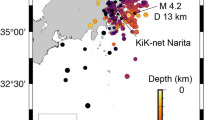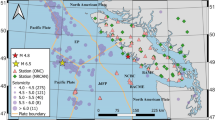Abstract
Based upon the one-year wind wave measurement data, collected from the South China Sea (SCS) at coordinates 20° 36.298′N, 110°45.433′E. by Acoustic Wave And Current (AWAC), we analyzed the wave characteristics and concluded that the most common wave direction was E and the second most common direction was ENE, the mean and the maximum values of significant height was 1.2 m and 4.36 m, respectively. The mean period was 4.0 s. We also evaluated the wave spectrums under conditions existing in three typhoons: Rumbi, Jeti and Utor. We found that unimodal spectrums occurred more often than others, and the maximum spectrum peak was 30.7911 m2 s. The minimum peak frequency was 0.0625 Hz, and the mean peak frequency was 0.126 Hz. The wave period is important for the design of marine structures, especially the position of peak frequency had a great influence on the stress calculation. Spectral analysis showed that the values of peak frequency distributed between 0.063 Hz and 0.217 Hz, with the mean value 0.114 Hz. We fit the normalized spectrum with 6 theoretical spectral models, out of which, the Wen spectrum, JONSWAP spectrum and Wallops spectrum were proved to give the best fit. What distinguished the Wen Spectrum from the rest was that it does not rely on the measured spectrum for parameter estimation. Hence, we recommend that the Wen spectrum should be widely used in marine construction.
Similar content being viewed by others
References
Bretschneider, C. L., 1959. Wave variability and wave spectra for wind-generated gravity waves. Technical Memorandum, United States Army Corps of Engineers, Beach Erosion Board, Washington DC, 118: 10–40.
Chen, J. C., Li, M. Q., and Wang, W. Z., 1990. A study on typhoon wave spectrum in the sea area adjacent Hong Kong. Tropic Oceanology, 9 (4): 1–8.
Hasselmann, K., Barnett, T. P., Bouws, E., Carlson, H., Cartwright, D. E., Enke, K., Ewing, J. A., Gienapp, H., Hasselmann, D. E., Kruseman, P., Meerburg, A., Olbers, D. J., Richter, K., Swll, W., and Walden, H., 1973. Measurements of wind-wave growth and swell decay during the Joint North Sea Wave Project (JONSWAP). Ergänzungsheft zur Deutschen Hydrographischen Zeitschrift, Reihe A, 8: 12, 95.
Hong, W. G., 1978. Discussion on statistical properties of waves and statistical methods in shallow water. East China Institute of Water Resources, 1: 1–50.
Hou, Y. J., and Wen, S. C., 1990. Wind wave spectra with three parameters. Oceanologia et Limnologia Sinica, 21 (6): 495–504.
Huang, N. E., Long, S. R., Tung, C. C., Yuen, Y., and Bliven, L. F., 1981. An unified two-parameter wave spectral model for a general sea state. Journal of Fluid Mechanics, 112: 203–224.
Huang, P. J., and Hu, Z. J., 1987. A fitting model of frequency spectrum for wind-generated waves in Jiaozhou Bay. Journal of Oceanography of Huanghai & Bohai Seas, 5 (3): 1–7.
Liang, S. X., Sun, Z. C., Yin, H. Q., and Niu, H. Y., 2015. Influence factors of typhoon wave forecast in the South Sea by SWAN model. Advances in Marine Science, 33 (1): 19–30.
Liu, W. T., 1998. The effect of wave period on coastal and offshore structures. Coastal Engineering, 17 (3): 1–5.
Pierson W. J., and Moscowitz, L., 1964. A proposed spectral form for full developed wind seas based on the similarity theory of S. A. Kitaigorodskii. Journal of Geophysical Research, 69 (24): 5118–5190.
Ren, S. H., Xie, B. T., and Song, Z. L., 2014. Statistical characteristics of the double-peaked wave spectra in the deep area of the South China Sea. Advances in Marine Science, 32 (2): 148–154.
Shu, F. F., Cai, F., He, J., Chen, Z. J., and Liao, K. M., 2012. Wave spectrum analysis of Guangdong Yangxi offshore area. Journal of Oceanography in Taiwan Strait, 31 (4): 557–564.
Sun, R., Hou, Y. J., Li, J., and Hu, P., 2013. The simulation of a typhoon wave in the northern part of the South China Sea. Marine Sciences, 37 (12): 76–83.
Wen, S. C., Zhang, D. C., Guo, P. F., Chen, B. H., and Tai, W. T., 1989. Improved form of wind-wave frequency spectrum. Acta Oceanologica Sinica, 8: 131–147.
Yang, S. Q., Hou, Y. J., and Liu, Y. H., 2015. Observed typhoon wave spectrum in northern South China Sea. Journal of Oceanology and Limnology, 33 (5): 1286–1294.
Young, I. R., 2003. A review of the sea state generated by hurricanes. Marine Structures, 16 (3): 201–218.
Zong, F. Y., and Wu, K. J., 2014. Research on distribution and variations of wave energy in South China Sea based on recent 20 years’ wave simulation results using SWAN wave model. Transactins of Oceanology and Limnology, 3: 1–12.
Acknowledgments
This research is a contribution of the Marine Energy Project. We acknowledge the financial support received from GHME2014ZC01.
Author information
Authors and Affiliations
Corresponding author
Rights and permissions
About this article
Cite this article
Shi, H., Cao, X., Wen, X. et al. The research on typhoon wave spectrum in northwestern South China Sea. J. Ocean Univ. China 16, 8–14 (2017). https://doi.org/10.1007/s11802-017-3115-0
Received:
Revised:
Accepted:
Published:
Issue Date:
DOI: https://doi.org/10.1007/s11802-017-3115-0




